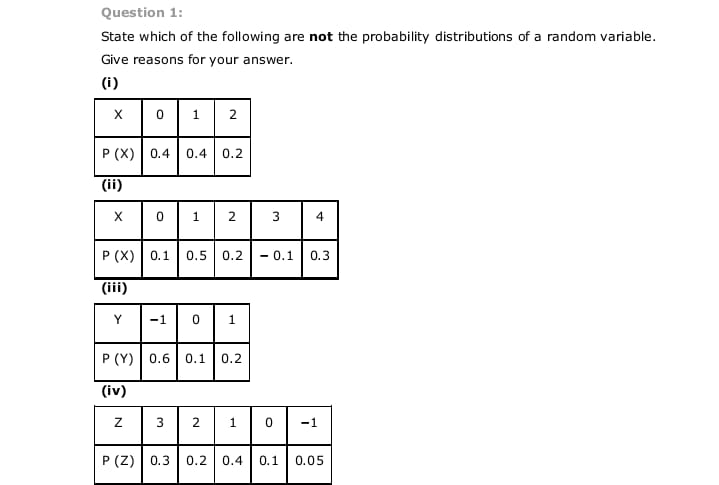# probability solve.
Question 3: Of the students in a college, it is known that 60% reside in hostel and 40% are day scholars (not residing in hostel). Previous year results report that 30% of all students who reside in hostel attain A grade and 20% of day scholars attain A grade in their annual examination. At the end of the year, one student is chosen at random from the college and he has an A grade, what is the probability that the student is hostler?Question 11: A fair die is rolled. Consider events E = {1, 3, 5), F = {2, 3} and G = {2, 3, 4, 5} Find (i) P (E|F) and P (FIE) (ii) P (E|G) and P (G|E) (ii) P ( (E U F)IG) and P ((E n G)IG)Question 8: A factory has two machines A and B. Past record shows that machine A produced 60% of the items of output and machine B produced 40% of the items. Further, 2% of the items produced by machine A and 1% produced by machine B were defective. All the items are put into one stockpile and then one item is chosen at random from this and is found to be defective. What is the probability that was produced by machine B?Question 1: State which of the following are not the probability distributions of a random variable. Give reasons for your answer. (i) X 1 2 P (X) 0.4 0.4 0.2 (ii) X 0 1 2 3 4 P (X) 0.1 0.5 0.2 - 0.1 0.3 (iii) Y -1 0 1 P (Y) 0.6 0.1 0.2 (iv) Z 3 2 1 0 -1 P (Z) 0.3 0.2 0.4 0.1 0.05Question 11: A manufacturer has three machine operators A, B and C. The first operator A produces 1% defective items, where as the other two operators B and C produce 5% and 7% defective items respectively. A is on the job for 50% of the time, B is on the job for 30% of the time and C is on the job for 20% of the time. A defective item is produced, what is the probability that was produced by A?P (Z) 0.4 0.05 Answer It is known that the sum of all the probabilities in a probability distribution is one. (1) Sum of the probabilities = 0.4 + 0.4 + 0.2 = 1 Therefore, the given table is a probability distribution of random variables. (ii) It can be seen that for X = 3, P (X) = -0.1 It is known that probability of any observation is not negative. Therefore, the given table is not a probability distribution of random variables, (iii) Sum of the probabilities = 0.6 + 0.1 + 0.2 = 0.9 # 1 Therefore, the given table is not a probability distribution of random variables. Page 51 of 103 Class XII Chapter 13 - Probability Maths (iv) Sum of the probabilities = 0.3 + 0.2 + 0.4 + 0.1 + 0.05 = 1.05 # 1 Therefore, the given table is not a probability distribution of random variables. Question 2: An urn contains 5 red and 2 black balls. Two balls are randomly drawn. Let X represents the number of black balls. What are the possible values of X? Is X a random variable? Answer The two balls selected can be represented as BB, BR, RB, RR, where B represents a black ball and R represents a red ball. X represents the number of black balls. AX (BB) = 2 X (BR) = 1 X (RB) = 1 X (RR) = 0 Therefore, the possible values of X are 0, 1, and 2. Yes, X is a random variable. Question 3: Let X represents the difference between the number of heads and the number of tails obtained when a coin is tossed 6 times. What are possible values of X? Answer A coin is tossed six times and X represents the difference between the number of heads and the number of tails. X (6 H, OT) =6-0=6 X (5 H, 1 7) 5-1=4 Page 52 of 103 Class XII Chapter 13 - Probability Maths X (4 H, 2T) =4-2 =2 X (3 H, 3 7) =3-3 =0 X (2 H, 4 7) =2-4=2 X (1 H, 57) =1-5=4 X (OH, 6 7) =0-6=6 Thus, the possible values of X are 6, 4, 2, and 0. O OQuestion 9: The random variable X has probability distribution P(X) of the following form, where k is some number: k. ifx=0 2k, ifx = 1 P(X) = 3k, ifx =2 0, otherwise (a) Determine the value of k. (b) Find P(X 2).Question 14: A class has 15 students whose ages are 14, 17, 15, 14, 21, 17, 19, 20, 16, 18, 20, 17, 16, 19 and 20 years. One student is selected in such a manner that each has the same chance of being chosen and the age X of the selected student is recorded. What is the probability distribution of the random variable X? Find mean, variance and standard deviation of X














